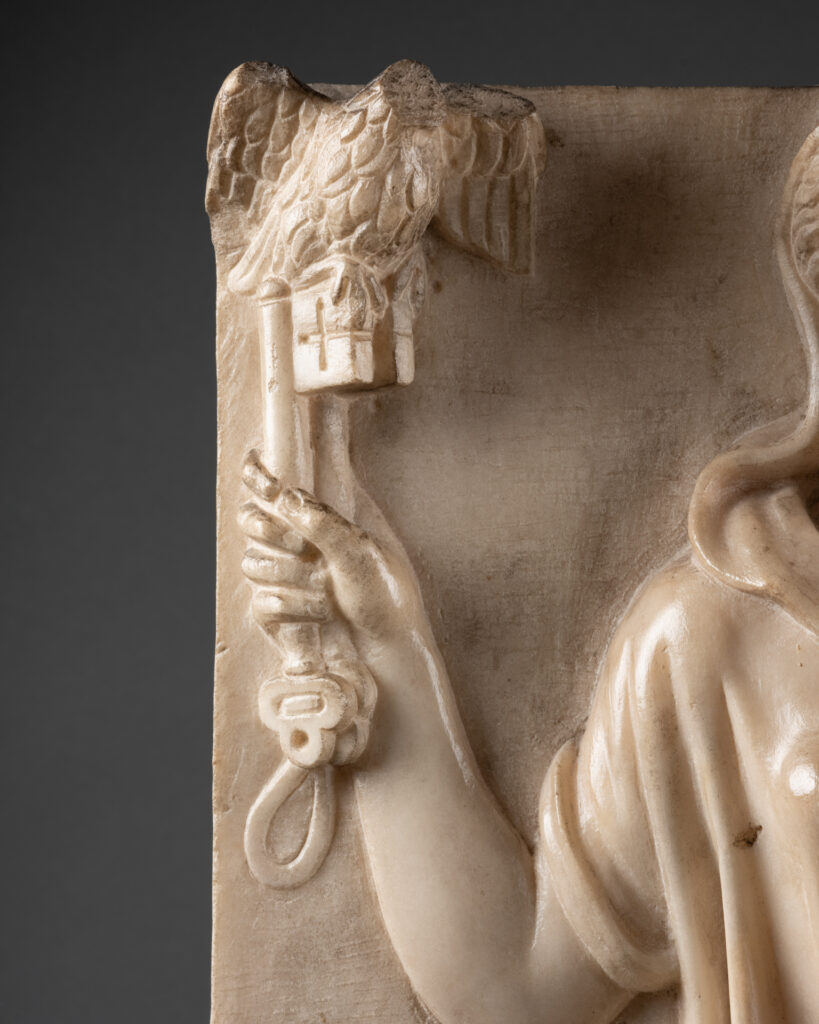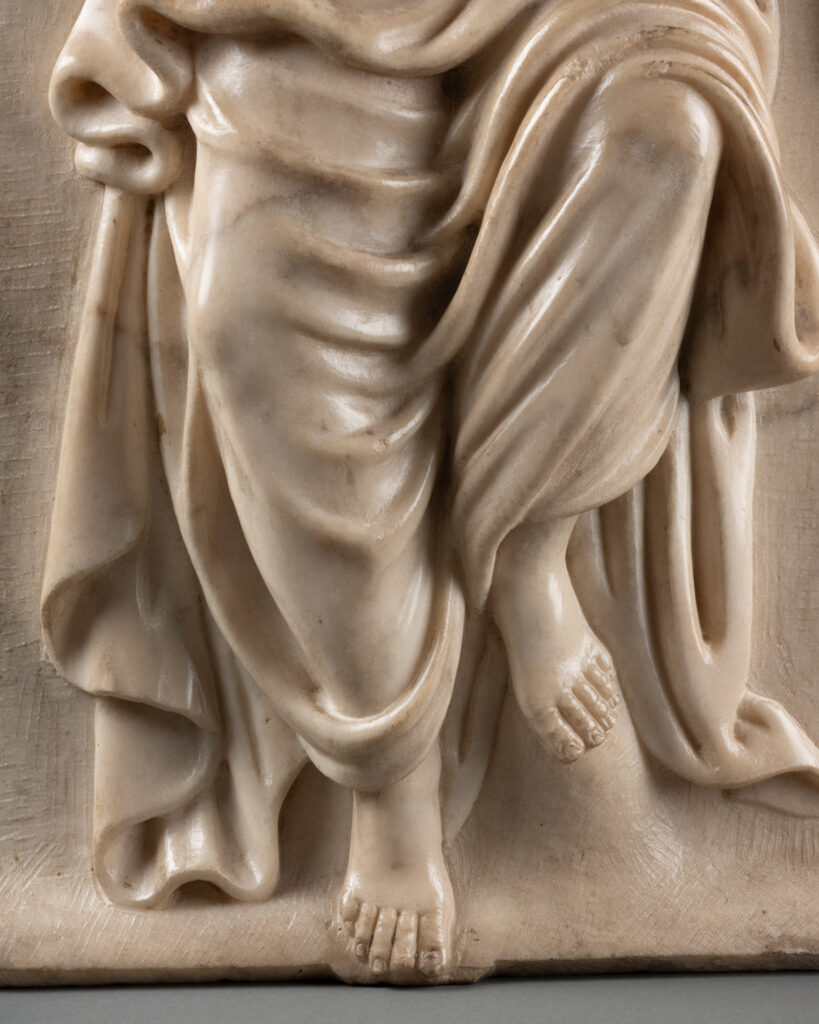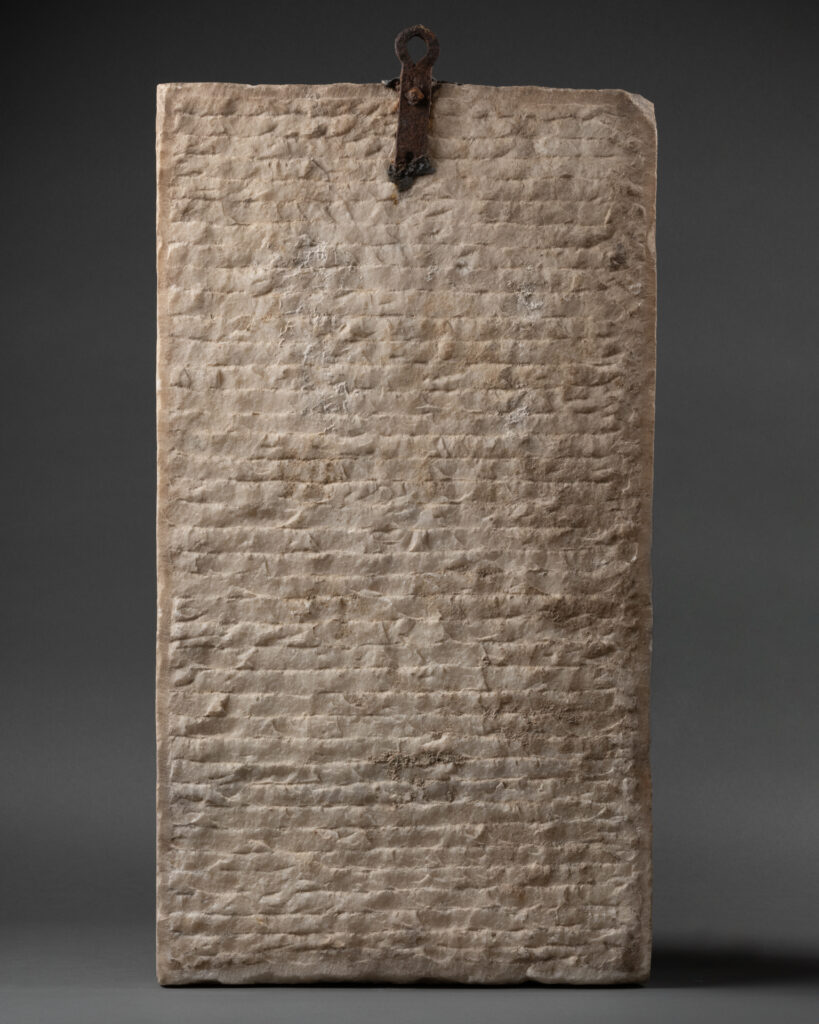This marble bas-relief depicting an Allegory of Christian Religion is typical of the 17th-century French School style.
We observe a woman, the top of whose head is covered by a veil revealing her wavy hair. His face is rendered in antique style with its aquiline nose, wide, pupil-less eyes, slightly ajar mouth and sculpted chin. Although his body is facing us, his head is turned to the right, but his neck remains straight. The figure wears a thin garment, glued to her body, revealing her navel and round breasts, which nevertheless ends in heavy, dense folds.
Seeming to be almost seated, the figure moves her left leg, bending it to place her foot on a mound. His right leg, too, bends in a lighter gesture to the right. Her right foot extends beyond the frame of the bas-relief, a symbol of the artist’s refinement.
The figure’s left arm twists in an impossible, serpentine motion, supporting a long, straight cross.
His right arm is raised, bent, and his hand holds two keys, linked by a strap, on which sits a bird, possibly a dove, with carved feathers.
Although the work’s symbolism is obvious, it is difficult to identify precisely. The attributes worn by the female figure (the cross, the two keys and the bird) are polysemous and can be found in many allegories, but it’s quite rare to depict them together.
The cross is that of the Crucifixion of Christ. It is an important symbol of the Church and Christianity. She is depicted in scenes linked to the Passion of Christ, but also in allegories relating to the Church, Religion and Faith.
The two keys are those given by Christ to St. Peter in the Gospel according to Matthew (16:19), where Jesus declares: “I will give you the keys of the kingdom of heaven. Whatever you bind on earth will be bound in heaven, and whatever you loose on earth will be loosed in heaven. Two keys are then handed over: one in gold (heavenly), the other in silver (earthly).
The dove embodies the Holy Spirit. Present in several passages of the Bible, the dove is a symbol of hope and faithfulness when it is sent by Noah to warn of the end of the Flood (Genesis, chapter 8). In the New Testament, the dove is used to represent the Holy Spirit, present at the moment of Jesus’ baptism: “He saw the heavens torn open and the Spirit descend upon him like a dove. There came a voice from heaven: ‘You are my beloved Son; in you I rejoice'” (Gospel of Mark, 1, 10-11). A symbol of Christianity, the dove, as the manifest form of the Holy Spirit, is a messenger of divine love.
The three attributes in this bas-relief are well-known symbols of Christianity.
From the second half of the 16th century onwards, religious representations, encouraged by the Council of Trent, took on a didactic, instructive and intellectual scope, intended to foster devotion among the faithful. Thus, some religious works of this period accentuate the emotion surrounding the martyrdom of the Saints and the Passion of Christ, while others respond to an intellectual and doctrinaire current. The Allegory presented here can be linked to this second trend, a consequence of the Council of Trent, which had repercussions on the arts well into the 17th century.
Our work can be compared with certain bas-reliefs of the 17th century French school.
This bas-relief by François Girardon of an allegorical figure, known as “La Mélancolie”, bears some similarities to our work: the figure’s attitude, the draped dress, the foot protruding from the sculpture’s frame, the raised hand.
Or in this bas-relief of an Allegory of Faith, attributed to Louis Le Conte and now in the Palais des Beaux-Arts in Lille, where the foot protrudes from the frame, the fine drapery gives a glimpse of the figure’s navel, and the right cross.
And finally, in this bas-relief by Jean Hardy, depicting Religion striking down Heresy, painted in 1688 and now in the Musée du Louvre.





